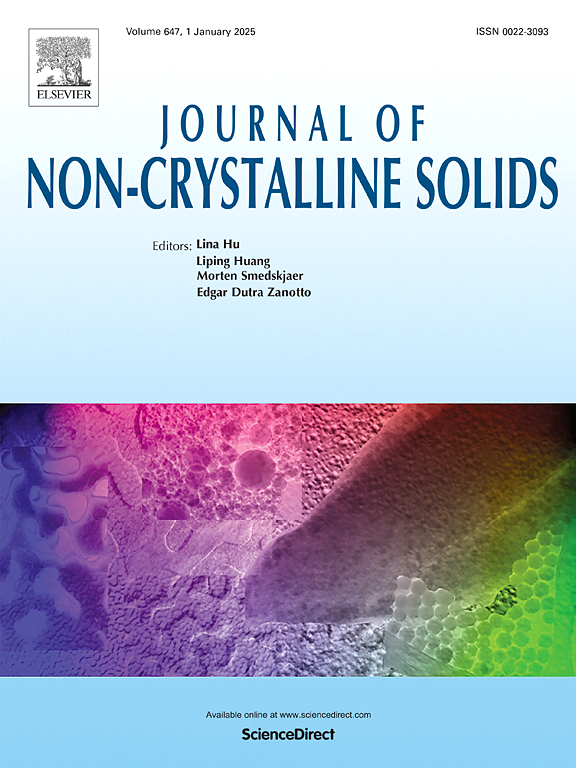Microscopic exploration of interfacial and wetting properties of graphene/silica heterostructures
IF 3.5
3区 材料科学
Q1 MATERIALS SCIENCE, CERAMICS
引用次数: 0
Abstract
Graphene/silica heterostructures have shown potential applications in broad fields, in which achieving well-defined composite structures is essential for optimizing non-crystalline composite properties and enabling new applications. However, the interfacial structures and properties of graphene/silica and the associated functions of underlying amorphous surfaces are not thoroughly understood yet. Herein, molecular simulations were performed to systematically investigate the adhesion, detachment, and wettability of graphene on amorphous silica surfaces. We simulated and constructed actual materials-oriented amorphous silica substrates with controlled morphology. It is demonstrated that graphene on amorphous silica surfaces exhibits three distinct contact states: suspended, partially conformal, and highly conformal. It is remarkable to show extremely low adhesion strength for graphene suspended on silica surfaces. The influence of different contact modes on the graphene/silica wettability was fully revealed for the first time. Grand Canonical Monte Carlo simulations were conducted to generate adsorbed water layers on the hybrid graphene/silica structures. The interfacial behavior of graphene/silica was also disclosed under humidity conditions, and meanwhile, the dynamic process of water inserting into the hybrid interlayer was captured. Overall, our simulations provide insight into tuning the morphology and wettability of graphene through substrate patterning, potentially paving the way for the design and application of graphene/silica heterostructures.
石墨烯/二氧化硅异质结构界面和润湿特性的微观探索
石墨烯/二氧化硅异质结构在广泛的领域显示出潜在的应用前景,在这些领域中,实现定义良好的复合结构对于优化非晶体复合材料的性能和实现新的应用至关重要。然而,石墨烯/二氧化硅的界面结构和性质以及底层非晶表面的相关功能尚未完全了解。本文通过分子模拟系统地研究了石墨烯在非晶二氧化硅表面的粘附、脱离和润湿性。我们模拟并构建了具有控制形貌的实际材料取向的非晶二氧化硅衬底。结果表明,石墨烯在非晶二氧化硅表面表现出三种不同的接触状态:悬浮、部分共形和高度共形。值得注意的是,石墨烯悬浮在二氧化硅表面的粘附强度极低。首次全面揭示了不同接触方式对石墨烯/二氧化硅润湿性的影响。通过大规范蒙特卡罗模拟,在石墨烯/二氧化硅杂化结构上生成了吸附水层。揭示了在潮湿条件下石墨烯/二氧化硅的界面行为,同时捕捉了水进入杂化夹层的动态过程。总的来说,我们的模拟提供了通过衬底图案调整石墨烯的形态和润湿性的见解,可能为石墨烯/二氧化硅异质结构的设计和应用铺平道路。
本文章由计算机程序翻译,如有差异,请以英文原文为准。
求助全文
约1分钟内获得全文
求助全文
来源期刊

Journal of Non-crystalline Solids
工程技术-材料科学:硅酸盐
CiteScore
6.50
自引率
11.40%
发文量
576
审稿时长
35 days
期刊介绍:
The Journal of Non-Crystalline Solids publishes review articles, research papers, and Letters to the Editor on amorphous and glassy materials, including inorganic, organic, polymeric, hybrid and metallic systems. Papers on partially glassy materials, such as glass-ceramics and glass-matrix composites, and papers involving the liquid state are also included in so far as the properties of the liquid are relevant for the formation of the solid.
In all cases the papers must demonstrate both novelty and importance to the field, by way of significant advances in understanding or application of non-crystalline solids; in the case of Letters, a compelling case must also be made for expedited handling.
 求助内容:
求助内容: 应助结果提醒方式:
应助结果提醒方式:


